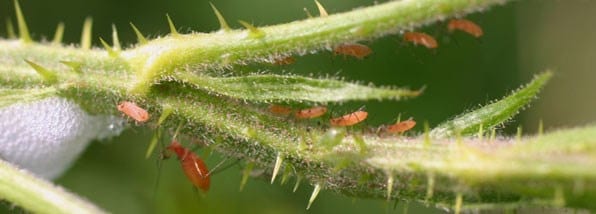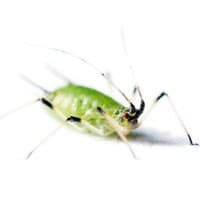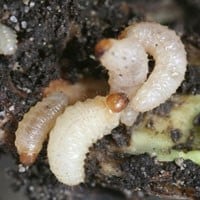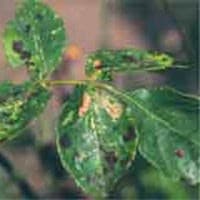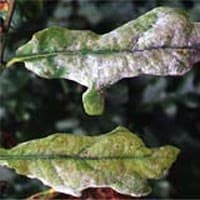Dealing with common pests and diseases
One of the first things you learn when you start gardening is that plants are not alone in the garden. There is a whole host of bugs that set up home in your beds and borders as well as an alarming range of microscopic bacteria, fungi and viruses that are only too happy to infect your plants. But DON’T PANIC! In fact, it’s a good thing to have a modest level of pests and diseases in your garden because these will support a range of beneficial insects and other creatures that will keep them in check without any intervention from you. Don’t rush to use chemical controls; these often cause more problems than they solve. They may wipe out your immediate dilemma, but that just leaves the way clear for neighbouring colonies of pests or diseases to invade without fear of attack from predators.
But in certain circumstances particular pests and diseases can get out of control. This can be due to an abundance of suitable food combined with ideal environmental conditions. This means that pest and disease problems are usually seasonal and are greatly influenced by the prevailing weather conditions. For example, aphids (which include greenfly and blackfly) enjoy a population explosion just as plants put on soft new growth in spring and the weather warms. If the weather is fair, plants grow quicker and pests breed faster. This is made worse by the fact that for the whole of the summer only female aphids are produced which can give birth to live young within a week of being born themselves. So, from a single aphid flying into you garden on a late spring breeze, a huge colony containing many thousands of individuals can be produced in a matter of weeks.
Some feel that chemical sprays are the answer. I don’t. I prefer my garden to achieve some kind of balance where there are always natural predators to help you control the pests. Use a spray just once and it can be years before this balance is achieved once more. Oh, you will always have a few pests, but then if chemicals are so effective, why do they have to be used time and again?
How to prevent problems
There is much you can do to prevent or avoid pest and disease problems getting a foothold in the first place.
- Choose healthy plants that are suitable for your situation rather than trying to force those you'd like to grow into a place in which they will never be happy.
- Use pest- and disease-resistant varieties where possible - this is particularly important for fruit and vegetables.
- Make sure all plants get the best possible start and don't receive a check in growth.
- Keep your plants growing strongly because they are well adapted to shrug off pest and disease attacks.
- Grow a wide range of different plants all mixed together so that if any pest or disease does get established, it has less chance of spreading to nearby plants of a similar type.
- Encourage beneficial creatures that help control any potential pest problems.
- Think ahead and put up traps and barriers where appropriate.
These are some of the basic principles behind pest and disease control in the organic garden which every gardener would be wise to adopt.
Know your plants
It’s also important to take time to get to know your plants; what they look like when they are growing well and are healthy. You will then be in a far better position to spot problems early. It’s just like spotting that a member of the family is a bit peaky and in need of attention. But spotting that a plant isn’t looking quite right is the easy bit, identifying the cause of its ailment often requires a bit of detective work.
Know your enemy
Before you can take action, you need to establish what’s actually causing the problem. This means venturing out into your garden and getting up-close and personal with your plants. Check them over regularly and act quickly to tackle problems early. For example, pinch out small colonies of insects or remove the disease-infected leaves as you walk around the garden. Become a garden detective, complete with magnifying glass to get a close-up view. The ten most common problems are outlined below, but there are literally thousands of other possibilities. If you are not sure what is causing the problem with your plant, check out the Crocus symptom selector to help pin-point your problem.
- Slugs and snails
- Aphids
- Vine weevil
- Blackspot
- Powdery mildew
- Whitefly
- Caterpillars
- Grey mould
- Rust disease
- Spider mite
Slugs and snails
Irregular holes are eaten from the middle of leaves.
Damage. Young plants and seedlings can be eaten to nothing. Sumptuous leaf plants like hostas can be left patchy, ugly and mauled.
Treatment. These fiends feast at night so you can go out and pick them off those plants most under attack. A ring of material that is uncomfortable to cross such as sharp grit or broken egg shells will sometimes discourage them. But only sometimes!. Plants in pots can be protected by greasing the rim with Vaseline and salt. Copper rings will also provide protection but are an expensive option and best only used on very specific plants. A biological control containing nematodes (called Nemaslug) is also worth considering. It is a natural, non-toxic product that is safe for both users and wildlife. The nematodes stay active for 6 weeks, so a single dose protects plants when they are emerging in the spring and are most vulnerable. Avoid using slug pellets which can lead to hedgehog and song thrush fatalities.
Aphids
Most commonly thought of as the small, fat, green insects covering roses. However, aphids can also be black, yellow, pink, greyish-white and brown. They are all about 2mm long, round and full of sap.
Damage. Bad infestations can reduce the vigour of a plant and leave it vulnerable to attack by other pests and diseases. Virus diseases can be spread by aphids as they move from one infected plant to another.
Treatment. Encourage the predators of aphids, such as ladybirds, lacewings and hoverflies, by planting nectar-rich flowering plants which attract them, such as buddleia, calendula, sedum, stocks, sweet William and wallflowers. Get a head start on the aphids by growing a patch of nettles with a small colony to help build up natural predators in your garden. Cut back the nettles when aphids appear in other parts of your garden to encourage the predators to seek them out. Lacewing houses can be bought to put up in the garden so they have a shelter for the winter.
You can artificially boost populations of lacewings and ladybirds as a biological control or introduce the parasitic wasp (Aphidius) and the gall midge (Aphidoletes) to deal with your aphid problem. Organic sprays include those based upon pyrethrum, derris and insecticidal soap, but even these will affect the balance in your garden and are unselective in their effects.
Vine weevils
Irregular notches taken from the margins of the leaves are made by the adult weevil. If a plant suddenly dies and appears to have no roots, this is the work of the larvae.
Damage. The effect on your plants will depend on the size of the root system and the number of grubs eating it. To start with the growth will slow, the plant may then begin to wilt and finally die as it no longer has sufficient roots to sustain it.
Treatment. Adult vine weevils cannot fly, they walk and mainly at night, so you can go out at night to find them and step on them. Or use a biological control containing nematodes (called Nemasys H) that feed on the vine weevil larvae. The nematodes come in powdered form and are watered on in late summer, while the soil is still warm but the grubs are, hopefully, still small enough not to have caused too much damage. Alternatively, try the chemical control to drench the compost, such as Bio Provado, or for new container plants try Levington Plant Protection Compost which also contains the same chemical. The drawbacks to these chemical is that they also kills the very useful ground beetles which are a friend in the garden as they feed hungrily on slugs and insects.
Blackspot
Purplish-black blotches appear on the leaves, which then start to yellow and fall early. In severe cases the stems also become affected.
Damage Badly affected plants may die as they are so seriously weakened they cannot withstand the winter frosts. It is very unsightly.
Treatment This fungus over winters on fallen leaves and stem lesions, so it is essential to clear away leaves as they fall and prune out any damaged branches in the spring. It is important to keep roses as healthy as possible so they can withstand attacks. So mulch with a good 7cm (3in) layer of well rotted farmyard manure around the base of the plants in the autumn and spring. It is also worth searching out roses that show resistance to blackspot.
Powdery mildew
White powdery mould appears on the leaves, stems and buds. Young growth is particularly affected. A fungal disease encouraged by the plant being dry at the roots with damp stagnant air around the top of the plant.
Damage. It looks unsightly and can cause leaves to drop early. If the plant is well established this is a relatively harmless disease. However, care should be taken with younger plants since these may be drastically weakened.
Treatment. Remove all dead leaves in autumn to prevent the spores from over-wintering. Mulch well in spring and autumn with well-rotted farmyard manure to prevent the roots drying out. If possible, prune plants so they have an open shape and air can move through the branches.
Whitefly
Tiny white creatures cluster under the leaves, they fly up into a cloud if the leaves are disturbed. They are most commonly found on houseplants and on plants in greenhouses.
Damage. Like most sap-sucking insects the whitefly will weaken the plant and make it susceptible to further attacks of pests and disease.
Treatment Tap the leaves and, as a cloud of flies up, suck them up with a small car vacuum cleaner. Whiteflies are also attracted to yellow paper, so you could try hanging strips of sticky yellow card which the whitefly stick to. Alternatively, use the biological control containing the parasitic was Encarsia in your greenhouse or conservatory.
Caterpillars
Leaves are stripped by caterpillars, the larval stage of moths and butterflies. Also check for frass – the tiny black balls of excrement that caterpillars leave behind.
Damage Young leaves can be eaten away and more mature plants are left with unsightly holes.
Treatment Leave them for the birds or pick off caterpillars by hand as soon as you see them. For really heavy infestations consider using the biological control based on a naturally occurring bacterium called Bacillus thuringiensis, which stops the caterpillar feeding and only infects caterpillars.
Grey mould
Stems and flowers become covered with a velvety brownish-grey, fungal growth.
Damage. A very common fungus which produces spores that are always around in the air. They attack plants through areas of damage. At first, small pale brown or white patches appear as the flowers start to rot.
Treatment. Controlling this fungus is very difficult because it is so widespread. Affected areas must be cut out and disposed of or burnt.
Rust
Orange-brown pustules develop on the undersides of leaves. These can often go unnoticed and the disease has taken quite a hold by the time the pustules appear on the upper leaf surface and are noticed.
Damage. Badly affected plants can be so weakened they are unable to withstand winter frosts.
Treatment. Remove and bin all infected leaves. Grow resistant varieties.
Red spider mite
Leaves become speckled, as though covered with hundreds or thousands of little dots. A badly infested plant becomes covered with fine webs.
Damage. Sucking out the sap weakens the plant. If the infestation is bad, so much sap can be taken that the leaves can dry up and fall off. House and greenhouse plants are most often affected but they can also be a problem outside in hot, dry summers.
Treatment. Red spider mites breed in hot and dry places. If you can increase the humidity around the plant you decrease the pest's reproduction rate. In greenhouses and patio areas the floors can be damped down. For a house plant a cunning frame made from an old coat hanger and a plastic bag will easily increase the humidity. Make sure you put holes in the bag to allow some air circulation. In the greenhouse or conservatory or in orchards and strawberry beds outside, a biological control that utilises the predatory mite Phytoseiulus permilis can be an effective control measure for this pest.



